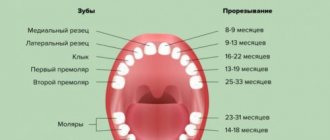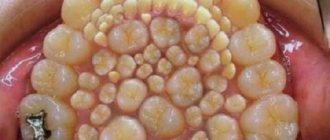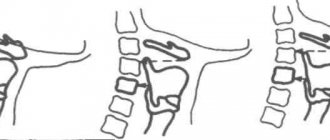From this article you will learn:
- what are gum diseases in children?
- gingivitis in children - symptoms,
- what to do if a child has an inflamed gum.
The article was written by a dentist with more than 19 years of experience.
Gingivitis in children is one of the most common diseases. However, gum disease in children is not limited to gingivitis. Inflammation of the gums in a child can also be observed with periodontitis of one of the teeth (in this case, an abscess or fistula appears on the gum). Also, the phenomena of gingivitis are always present against the background of a child’s illness with herpetic stomatitis.
Before starting treatment, it is very important to correctly differentiate gum disease in a child in order to avoid incorrect and thus useless treatment. Below we will look at each of these diseases separately.
Gingivitis in children: symptoms, treatment
Gingivitis is an inflammation of the marginal gum adjacent to the teeth and interdental papillae (Fig. 1-3). Gingivitis is the very initial phase of inflammation, and if it is not treated, the inflammation will increase, the bone around the tooth may begin to deteriorate, and tooth mobility will also appear.
Gingivitis in children: photo
Gingivitis in children: symptoms
- bleeding gums,
- pain when brushing teeth,
- swelling of the marginal gums and interdental papillae,
- redness of the gums – red gums in a child are a symptom of the acute phase of inflammation,
- cyanosis of the gums – a child will have blue gums if acute inflammation becomes chronic, with mild symptoms.
An objective examination of the oral cavity reveals accumulations of soft plaque and hard dental deposits, and, as a rule, a large number of carious teeth (24stoma.ru).
Childhood gingivitis: causes
So, we answer the question: why do a child’s gums bleed... The cause of the development of gingivitis is the microbial flora of dental plaque. Due to poor hygiene, plaque accumulates, the microflora of which actively produces toxins and inflammatory mediators. These toxins and mediators, acting on the gums, cause an intense inflammatory reaction in it, which is manifested by the development of edema, bleeding, etc.
Those. The main factor in the development of gingivitis is soft microbial plaque and dental deposits, i.e. bad hygiene!
Factors contributing to the development of gingivitis - in addition to the main factor, there are additional factors that do not themselves cause inflammation, but contribute to its occurrence. ..
- Local factors – → defects in dental filling (overhanging edges of fillings), → malocclusion: crowding of teeth, → sharp edges of carious cavities (Fig. 4), → wearing orthodontic appliances (Fig. 5), → mouth breathing, → anomalies in the attachment of lip frenulum and language. The listed local factors do not themselves cause gingivitis, but they complicate oral hygiene and therefore contribute to the accumulation of plaque.
- Common factors are cardiovascular and gastrointestinal diseases, infectious diseases (including ARVI), hormonal and hereditary diseases. These factors lead to a change in the body's reactivity (decreased immunity) - due to which the resistance of the gums to toxins and inflammatory mediators produced by the microbial flora of dental plaque is reduced.
Gingivitis: treatment in children
As we said above, gingivitis in children occurs only when microbial plaque and dental deposits accumulate on the teeth. In this regard, appropriate therapeutic measures are selected. Treatment of gingivitis in children should include the following measures:
- Removing plaque and tartar –You can remove dental plaque by conducting a session of professional oral hygiene at a dentist’s appointment. Dental plaque is removed using ultrasound, after which the teeth are polished with special brushes. The procedure is painless.
In Fig. 6 you can see the ultrasonic tip, which is used to remove dental plaque. Touching the tip of the nozzle to dental plaque causes destruction of the attachment of tartar to the teeth.Important : gingivitis in children - treatment consists primarily of removing soft microbial plaque and hard dental deposits from the teeth using ultrasound. An attempt to use various rinses, gels with antibiotics and antiseptics, toothpastes with herbs will, of course, lead to a temporary subsidence of inflammation. But as soon as the use of medications ends, inflammation will develop with renewed vigor. Anti-inflammatory therapy should be used only after removing tartar and plaque!
- Anti-inflammatory therapy –Bleeding gums in children is one of the main symptoms of gingivitis, along with pain when brushing teeth, swelling and redness of the marginal gums. In order to quickly relieve symptoms, it is necessary to conduct a course of anti-inflammatory therapy. A child's inflamed gums can be treated with the following dosage forms: antiseptic rinses, applications.
Antiseptic rinses:- 0.05% CHLORHEXIDINE SOLUTION (instructions for the drug) Course 10 days (no more), 2 times a day in the morning and evening after oral hygiene. It is advisable to rinse your mouth for at least 30-40 seconds. There are no contraindications based on age. The solution has a bitter taste.
MIRAMISTIN (instructions for the drug) rinse solution for children from 3 years old. Rinse 3-4 times a day for 30-40 seconds. Miramistin is somewhat inferior to chlorhexidine in terms of potency, and besides, it is much more expensive.
- Non-alcohol infusions of herbs - chamomile, sage, eucalyptus... (except oak bark)
Anti-inflammatory gels, ointments:
Questions are often asked: what to smear on a child’s gums, what is better – gel or ointment for gums for children? Children's ointment for gums will be noticeably inferior in strength to gels for gums. Gels are much better retained on the moist mucous membrane of the oral cavity. In addition, medicinal substances from gels penetrate the mucous membrane more easily than from ointments. Therefore, the effectiveness of dosage forms based on gels is higher.
- CHOLISAL (instructions for the drug) Gel for children's gums.
Active ingredients: choline salicylate and cetalkonium chloride. It has not only an anti-inflammatory, but also an analgesic effect. It can be used not only in the treatment of gingivitis, but also during teething for the purpose of pain relief (rubbed into the teething area). There are no contraindications based on age. It is applied to the marginal part of the gums and gingival papillae, primarily from the front surface of the teeth. The course is no more than 10 days. Apply 2 times a day (in the morning and in the evening before bed) immediately after the end of the antiseptic rinse. After application, it is advisable not to eat or rinse your mouth for 2-3 hours (you can drink). - METROGYL DENTA (instructions for the drug) Gel for gums for children. Active ingredients: metronidazole 10 mg, chlorhexidine 0.5 mg Can be used from 6 years of age. Apply to the marginal part of the gums and interdental papillae in the area of all gum teeth 2 times a day. It is not recommended to wash off the gel. After applying the gel, it is advisable not to eat or rinse your mouth for 2-3 hours (you can drink). The duration of the course of treatment is no more than 10 days.
If you decide to treat your child yourself , then you need to know that removing dental plaque before starting treatment is mandatory. If anti-inflammatory therapy is used without removing soft and hard plaque, it will cause the following:
→ symptoms (bleeding, swelling, etc.) will certainly decrease or disappear. But, as soon as the course of treatment ends, the symptoms will arise again. This is because the cause of gingivitis (microbial plaque) was not removed and treatment was only given for symptoms.
→ the transition of gingivitis from an acute form with severe symptoms to a chronic form with scanty symptoms, which with a high probability can result in the development of periodontitis in a child.
In carious cavities there is a lot of infection, which causes not only tooth decay, but also inflammation of the gums. In young children, the so-called bottle form of caries often occurs, which is associated not only with poor hygiene and improper feeding of the child. When treating caries in children under 3 years of age, as a rule, dental clinics use the method of silvering teeth. Despite the fact that this method does not require drilling of teeth, it has major disadvantages, and is also inferior in effectiveness to others, for example, the method of deep fluoridation or remineralization therapy.
Types of gingivitis
The disease can progress differently, depending on the type of gingivitis. Treatment is prescribed by a doctor individually in each specific case.
Important. The acute form of the disease is much more common in children. The chronic form occurs in the absence of treatment.
Classification
The disease is classified according to several criteria:
- zone of distribution - local (one interdental papilla is inflamed) or generalized (most of the gum is inflamed) gingivitis;
- nature of the course - acute or chronic stage;
- the degree of change in the mucous membrane of the gums - catarrhal, ulcerative, hypertrophic, atrophic, marginal, desquamative.
According to the severity of the disease, three forms are distinguished - mild (damage to one or two interdental papillae), moderate (inflammation of the gum edge), severe (damage to most of the gum).
Catarrhal
Acute catarrhal gingivitis is most often diagnosed during teething or changing teeth, as well as against the background of previous infectious diseases.
Characteristic features:
- severe redness and swelling of the affected areas;
- discomfort in the gums, pain, itching, bleeding of the gums when brushing teeth or eating;
- bad breath;
- low-grade fever.
There is a feeling of malaise, but the general condition is not cause for concern.
Marginal
It usually occurs in childhood and indicates poor oral hygiene. It goes away immediately in a chronic form, another name for the disease is “dirty” gingivitis. It manifests itself in bleeding gums, usually when brushing your teeth. The marginal tissues are swollen, hyperemic, with a cyanotic tint. Treatment consists of removing plaque and following oral hygiene rules.
Desquamative
The main feature of desquamative gingivitis is epithelial sloughing. The affected areas are also distinguished by increased redness in the form of individual spots. In the initial stage, the disease does not cause concern, but later, in the absence of treatment, the mucous membrane becomes loose, pain and burning in the gums appear, and erythema spots grow. When neglected, blisters with yellowish contents appear in place of the spots, then ulcers form in place of the blisters. At the same time, sleep is disturbed, headaches and irritability appear.
Important. Desquamative gingivitis occurs cyclically with sudden exacerbation without provoking factors. Remission is long-term, up to two years.
Hypertrophic
The second name is hyperplastic. The disease is typical for prepubertal and pubertal age and is associated with the influence of sex hormones on gum tissue at this particular age. In the fibrous form, there is an overgrowth of the papillae, the gums are greatly enlarged and partially cover the teeth. The edematous form is more severe - the gums are enlarged and hyperemic. When brushing your teeth and chewing food, the pain and bleeding noticeably intensify.
A dental examination reveals severe gum overgrowth, looseness and swelling of the gingival papillae, and the presence of false gum pockets. Also, a distinctive feature of hypertrophic gingivitis is a significant amount of plaque on the teeth.
Ulcerative
The ulcerative form is the next stage of catarrhal gingivitis against the background of decreased immunity after influenza, acute respiratory viral infections, infectious diseases, and herpetic stomatitis. Another reason is hypothermia.
Characteristic symptoms:
- hyperemia, swelling, bleeding gums;
- the appearance of ulcers;
- general weakness, low-grade fever;
- bluish tint near the gums.
In the absence of adequate therapy, the disease passes into the ulcerative-necrotic stage - the ulcers are covered with a gray-green coating, a putrid odor from the mouth appears, and saliva becomes viscous. Sleep and appetite disturbances are observed, the child becomes capricious.
Atrophic
In most cases, the disease is chronic and is detected during examination by a dentist. It is observed in case of improper filling of teeth, in the presence of congenital defects of the frenulum of the tongue, or in case of malocclusion.
Symptoms – not clearly expressed:
- slight bleeding gums;
- exposure of tooth roots;
- reduction in gum volume.
In the initial stage, there are no inflammatory signs or pain, the gums are not hyperemic. Then, with the gradual exposure of the roots of the teeth, discomfort and pain appear when eating hot or cold food. In the absence of treatment, progressive dystrophic changes in the gingival margin are observed.
Prevention of gingivitis –
WHO (World Health Organization) experts have identified the following main measures for the prevention of gingivitis:
- Proper oral hygiene –
firstly, it includes the correct technique for brushing the child’s teeth and gums, depending on age. After all, many parents simply don’t even know at what age they should start their child’s oral hygiene. And you need to start it even before the first teeth erupt. - Choosing the right toothpaste - secondly, toothpastes can provide significant assistance to parents in the fight against caries and gingivitis. If hygiene is of high quality, and as a result the child does not have caries and gingivitis, you can use almost any children’s toothpaste. However, in case of insufficient hygiene, toothpastes with special components (for example, amino fluoride) that can compensate for lack of hygiene to a certain extent can come to the rescue.
You can learn about how to choose the right toothpaste for a child, as well as read the ratings of such toothpastes, in the article: → “Rating of toothpastes for children of different ages”
- Balanced nutrition for children - we are talking about diet (avoid snacking) and limiting the intake of easily digestible carbohydrates (sweets, cookies, sweet drinks, etc.). Easily digestible carbohydrates should be given to the child only immediately after meals. After which you need to brush your teeth for 5 minutes.
Causes
The main cause of childhood gingivitis is almost always an insufficient level of hygiene and prevention of oral diseases.
Parents often make the mistake of teaching young children to brush their teeth, but not supervising this process in the future. A child, not understanding the importance of oral hygiene, can turn the process of brushing teeth into a fun but useless game. The result in the form of plaque is usually visible, or rather, on the teeth and gums.
Plaque on children's teeth serves as an excellent food source for microorganisms, including pathogens. As the colony of microbes grows, it causes a response from the body—inflammation occurs.
Although inflammation is a natural reaction of the body struggling with an undesirable effect, this fight does not pass without a trace - the body consumes internal resources, as a result of which the inflamed tissue is gradually destroyed.
The following factors also contribute to gingivitis in children:
- unbalanced diet, lack of important minerals and vitamins, especially vitamin C;
- injuries to the mucous membrane of the gums due to malocclusion, chewing hard food, burns from hot food or drink;
- viral infections;
- diabetes;
- hereditary predisposition.
Inflammation of the gums in a child with periodontitis -
If left untreated, dental caries gradually turns into pulpitis, and then into periodontitis. In moments of exacerbation, periodontitis occurs with the appearance of swelling of the gums, the formation of cysts, fistulas on the gums with purulent discharge.
In Fig. 9-10 you can see in the projection of the roots of the destroyed teeth (in both cases this is the central upper incisor) - there is a limited swelling on the gum, filled with pus. In both cases, the inflammation was caused by an infection in the area of the root apex of the central upper incisor.
Read more about gum inflammation in children with periodontitis in children - here
Treatment
Therapy for this pathology must be comprehensive. It includes medication and special procedures.
For this purpose, the following methods are used:
- Treatment of all forms of gingivitis begins with getting rid of plaque. They are removed by the dentist using ultrasound, then polished using brushes and a special composition. If professional cleaning is not performed, home treatment is ineffective. As soon as it ends, the disease worsens again.
- Rinsing with antiseptic agents is used. For this purpose, solutions of Miramistin, Furacillin, Chlorhexidine and infusions of medicinal herbs (eucalyptus, chamomile, calendula, sage) are used. Rinse your mouth with them three or four times a day, after meals. Before rinsing with herbs, remove all food debris. The course of treatment lasts up to ten days.
- Lubricate the gums with gels that have anti-inflammatory properties. The following drugs are used in gel form: Cholisal, Soloseryl, Asepta (no age restrictions) and Metrogyl Denta (used in children over six years old). The drug is applied to the gums twice a day. After this, you should not eat or rinse your mouth. Drinking is not prohibited. The course of treatment lasts up to ten days.
- In severe forms, antibiotic therapy is used. The medicine is selected by the doctor individually, based on the sensitivity of the bacterial flora.
It is necessary to cure all the child’s teeth affected by caries, followed by fluoridation and silvering. Alcohol preparations are not used for treatment. They increase irritation.
Symptoms of gingivitis against the background of herpetic stomatitis -
Very often, with viral herpetic stomatitis, concomitant acute gingivitis occurs. In this case, the periodontal papillae and the marginal part of the gums increase due to swelling and become bright red. Read more about gum inflammation due to stomatitis in the article: “Treatment of various forms of stomatitis in children.” We hope that our article on the topic: Gingivitis in children treatment was useful to you!
Sources:
1. The author’s higher professional education in dentistry, 2. Personal experience as a periodontist, 3. The European Academy of Paediatric Dentistry (EU), 4. National Library of Medicine (USA), 5. “Pediatric therapeutic dentistry. National leadership" (Leontyev V.K.).
Prevention
Prevention of the disease consists of following simple rules.
Recommended:
- You must regularly visit the dentist once every six months;
- timely treatment of teeth affected by caries;
- carries out hygienic cleaning of the oral cavity twice a day;
- rinse your mouth after eating with special rinses;
- choose the right toothbrush, it should be soft and not injure the mucous membrane;
- limit sweets;
- the child needs a balanced diet with sufficient vitamins and microelements;
- examine the oral cavity during teething;
- monitor the condition of the oral cavity during colds.
Compliance with these conditions helps to avoid relapse of the disease.











